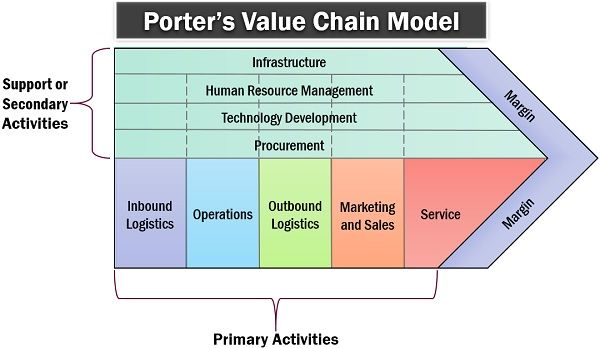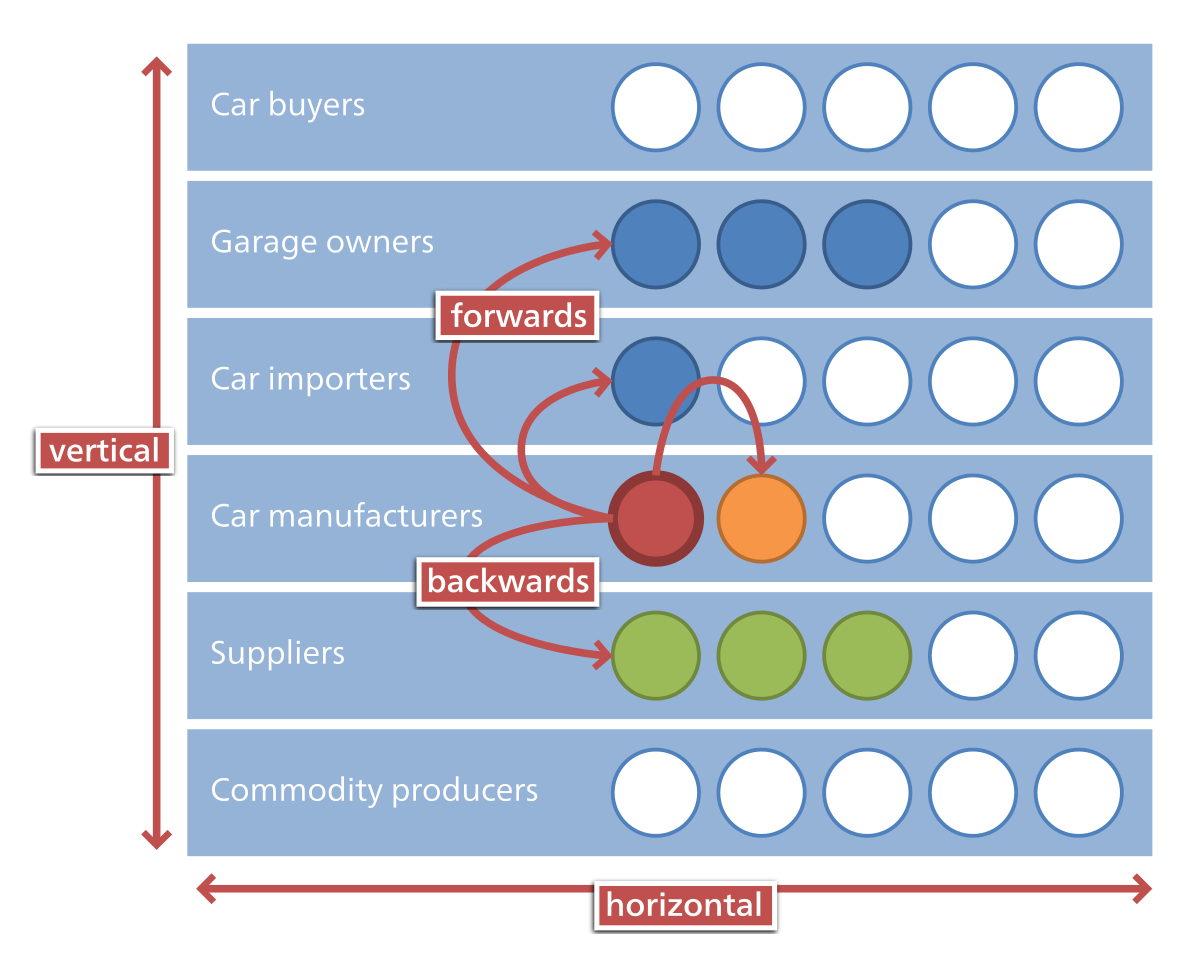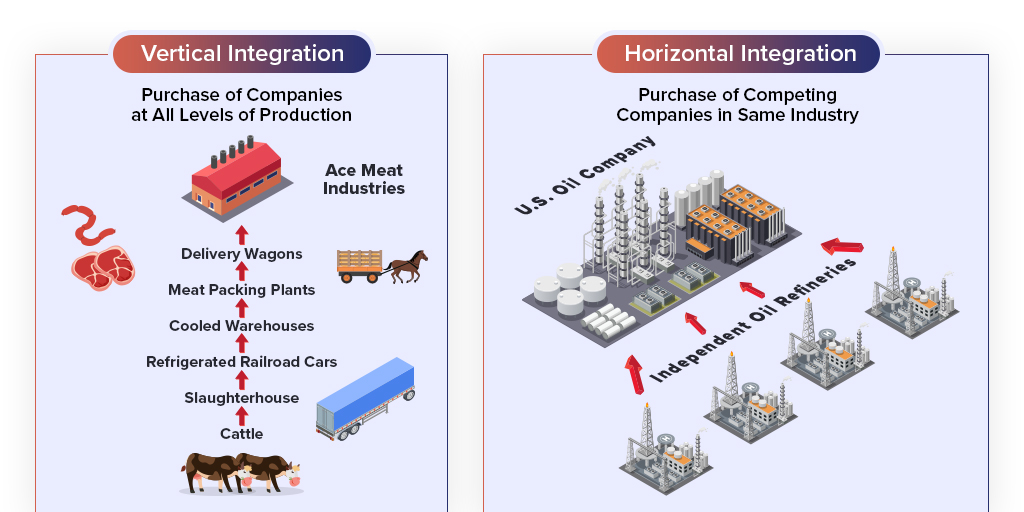Vertical integration and horizontal integration both are equally important and very interesting topics to understand for business. Especially, if you want to start a business then you need to realize the concept of these two methods.
Vertical integration means two companies in the different levels of the value chain starting working together. And
Horizontal integration means one company acquiring another company in the same level of the value chain for capturing the market. For example, one restaurant buys another restaurant.
Undoubtedly, both have some differences. But the question is why do you need to know those concepts? And what is the value chain? For your satisfaction yes I will go to discuss everything. So keep continuing reading.
So you will know
What is Vertical Integration?
Now let’s start with the vertical integration. As you know that when two different levels of value chain companies started working together than this method is called vertical integration. In this strategy, one company acquired the other company in the same industry but in the different value chain to improve the supply chain process.
Firstly, you understand the vertical process and integration then I will tell you the overall value chain concept.
Shortly, the corporation or company get advantage from this method such as reducing overall operational cost, they have more control of the power of suppliers, the overall supply chain systems and also they build a control system over the industry.
After sometime later you will know every vertical strategy in this blog for sure.
Now secondly, understand the value chain.

Michael Eugene Porter’s Value Chain
Porter introduced the best ever business model which is called the porter’s value chain. In this model, he discussed about 9 activities. Those 9 actions also divided into 5 primary activities and 4 support activities.
Let’s talk about one and one. Firstly, look at the 5 stages of the value chain
By Inbound Logistics
Whenever a company acquires a new thing or bringing inside to the company it is known as inbound logistics. Although, the company also managed their warehouse or inventory and storage system so that a business can maintain their work.
For example – a computer company brings microchips from other companies. So now you can realise why a company acquires a new company? For the demand of production.
By Operations
It means the overall manufacturing processes. Such as from collecting raw materials to finished goods. These whole processes are called the operations. A company maintains its operation for better productivity.

Outbound Logistics
After that, the finished goods go to the customer. But before reaching the consumer some processes still is going on. Which is called outbound logistics. Such as the packaging and after that the shipment processes. Now let’s move to the next one.
Marketing and Sales
Undoubtedly, marketing and sales are the most important parts of a company. In this activity, a company manages its overall distribution channels and the pricing of products, also they create promotions so that they can aware customers. You might see all new product ads on tv or on your mobile. These are the part of the marketing.
By giving Services
At last, giving the best services to the customer after shipment. If you don’t value your customers they will move back for sure. Mostly all companies value their consumers.
For example, if you buy a mobile and after that, you might want to be replaced or want to repair your mobile. So where do you go? In this case, the mobile company provides customer service. They repair and make maintenance of overall products so that all rest of the consumers will be satisfied.
Procurement
Now, this is something new to you, I can understand. So this is a support system so that the company arranged the best materials. This department instructs the company to buy the right materials for the production.
Technology Development
This department makes an overview report of all products, their delivery time, inhouse resources and also helps the product development.
Next is
Human Resources
You might be familiar with this department. It supports the overall company requirement. In other words, this department of a company trained new employees and also hiring-related people for companies.
At last
Infrastructure
Lastly, but most important thing in the company is the infrastructure of a company. It comprises all account or financial services, overall administration, planning and quality control. So the company managed everything. Also, know Porter’s Five Forces.
I hope now you have a clear picture of why businesses move to vertical integration.
Because of,
No.1. The supply chain process – if companies want to expand their business then they need to control the supply system.
As well they also want to reduce the production cost, when a company starts working with another company they have a balance between cost and transportation cost. It provides the company profitable and the value obviously.
For all this reason, the company furthermore gains control of the industry.
Now you understand the different vertical integration.
Types of Vertical Integration
Afterwards now you need to know the types of integration.
There are two types of integration. Which are backward and forward integration.
Backward Integration
On the one hand, it is a method of acquiring different value chain companies who provide the raw materials. Sounds complicated? Ok, I will give you an example,
Suppose you have a juice company and you want to make your juice making process faster so you have an option to buy or acquire fruit suppliers. So that the overall progress will be faster than your competitors.
Basically, a company acquires the raw material company so they can make a faster manufacturing process.

Forward Integration
On the other hand, forward means companies buy or acquire and start working with the marketing or distribution company so the whole distribution system takes control of the company.
For example, one laptop company can start their own distribution channel where they sell all products directly to the customer. In this case, the overall distribution can be taken control. Know in-depth of those two integrations.
Good and bad sides of Vertical Integration Strategy
This is important to realise the overall strategy used by companies. As I mentioned above, companies chose this method to reduce cost, better supply chain and better distribution and capture the market. But now you might be asking, so all companies become profitable after using this technique?
The answer is, it has both advantages and disadvantages. Then look for all.
- Advantages of good sides of this integration is definitely cost deduction.
- Improve the market share
- More control of supply process
- More product efficiency
- Provides value edition
- Provides more consumer services
- Build up more support system
- New abilities to enhance
- Opportunities to increase sales
- Opportunities to create more products

Similarly, there are some disadvantages or bad sides of this strategy.
- Disadvantages are such as cost-efficiency. Obviously, new places have an overall expense.
- Also, new contracts sometimes have a maintenance problem. Because managing the new place, although their inhouse operational management system is sometimes difficult.
- This strategy leads to making low-quality products as well because of expanding the quantity.
- The political environment also impacts a lot.
- The human resources problem.
- Technological environment impacts as well. If the company needs technical devices.
- Lastly, the legal system of that new place impacts the overall operations.
However, some small companies don’t use this vertical integration but mostly well-known companies use this method for better productivity.
For example, you can check Apple, Amazon, who use this vertical integration strategy.
What is Horizontal Integration?
Additionally, you also need to understand the horizontal integration. It is very similar in sounds but there is a difference between both the two methods. So without delay let’s get started.
As I already mentioned above, when a company acquires the same level of the company to capture the overall markets then the method is called horizontal integration.

Let’s take an example, if a restaurant wants to expand their business then they have several options. They can open a new restaurant or they can acquire previously organized restaurants for quick adaptation.
So in this case, when one restaurant acquired another organised restaurant they earned the all value in their own restaurant.
Reason of Horizontal Integration
Most importantly, majorly all companies use this integration for expanding the business.
Secondly, to build the power.
Thirdly, capture the board customers.
Fourthly, obviously for geographical expansion.
Fifthly, finish the competition.
Lastly, the overall market gain.
When a company makes an expansion strategy they often do for the same reasons.
Horizontal Growth
Now you already understand the concept of horizontal integration. Now at this time you also need to know the growth of this method.
Growth means overall growth rate. When the company captures the overall market, it creates a monopoly. Means when capturing the same label value chain company it provides the overall development of a company.
Market growth furthermore enhanced.
Supply and production growth is happening.
More control gained by capturing the distribution channels.
For example, Google, Microsoft used this technique for capturing the whole market.
Benefits of Horizontal Integration
Undoubtedly, the most important benefit or advantage of this technique is cross-selling.
Cross-selling is obviously a fast choice of a company. For this, a company can increase sales and earn profit.
Finish competition – as I already discussed above, so in this case, the company wants to create a monopoly which is based on acquiring the previous well-known company so that they can make sales by existing consumers. Also, one brand becomes famous by finishing their competitors.
They have will power to make the whole market by their sides.
It creates the distribution and supply faster, better and also has more control power to lead the industry.
Horizontal disadvantages
But creating a monopoly is always not good enough for a company as well. So horizontally integrated strategy also has some disadvantages.
Firstly, bigger is not often good for a company. Expanding business means taking charge of extra responsibilities.
Also, it creates the control of the resources problem and sometimes security problems.

Summary
At last, I hope you understand everything about vertical and horizontal integration. But take a quick look at overall. So if a company wants to expand their business they either can use the horizontal path or they can use the vertical process for better outcome. On one hand, the vertical method has more control over the distribution and supply. While on the other hand, the horizontal method has more control over the market. So with this purpose in mind go ahead and choose your own techniques.
Frequently Asked Questions
Many companies use this technique but Apple, Amazon, Google all are well known for their vertical strategy.
As you already know that in this technique one company acquired a different level value chain company, so in here monopoly means a company acquired more supply and distribution channels to create a monopoly.
In this technique when a company acquired many same level companies then a monopoly market is created.
Both are different strategies used by different companies. Both have some advantages and some disadvantages. So both are equally important and valuable methods of business.



